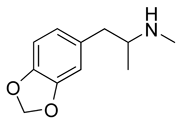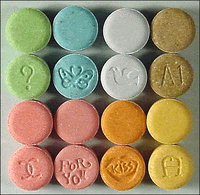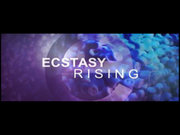When I began researching the topic of a street drug named "Ecstasy," my first reaction was, "Omigawd, not another one!" In ten years of experience as a clinical psychologist in the prison system, I saw there is practically nothing that people won't stuff into any orifice, bathe in or shoot up their veins in the endless quest to get high. I once had a patient who mainlined peanut butter and subsequently lost three fingers to gangrene.
Ecstasy Is Now A Culture
Yet, this Ecstasy is no ordinary street drug--it's a culture. It deserves special mention, if only for the reason that both the USMA and USAFA have recently--and sadly--found it necessary to court-martial, dismiss from service and sentence to Leavenworth, several cadets who were abusing this drug. Yes, our armed forces mean business when it comes to drug abusers.
I was surprised to find that the most popular variant of Ecstasy (3,4 methylenedioxymethamphetamine, or simply MDMA if you ever have a need to know) was first synthesized and patented in Germany as an appetite suppressant as early as 1912. However, it wasn't until 1 July 1985 that the Drug Enforcement Agency declared MDMA a Schedule 1 Controlled Substance. That's a roundabout way of saying in the U.S.A. Ecstasy is illegal
How Out Of Control Is Ecstasy?
The New York Times reports that around one million tablets are smuggled into the U.S. every day. Illegal use of Ecstasy has skyrocketed since the early 1990s, and the armed forces aren't immune from having their share of illegal abusers. Ecstasy is an amphetamine, with sister drugs like MDE ("Eve"), MDA ("Love"), PMA ("Death"), MDEA and MBMB. These are all popularly known as "Rave drugs" or "club drugs" because they are frequently gobbled in mass quantities at all-night parties or "Raves." A moderate 75-150 milligram pill dose is reputed to give the user a high lasting from one to three hours. MDMA is definitely the "young man's drug of choice."
Ecstasy Is Harmless? Says Who?
For the past 10 years or so there's been a popular but unfounded belief by the lay public that these Rave drugs are relatively harmless and only promote feelings of euphoria, social closeness and mild LSD-like hallucinations. Is this so? Have we finally found that wonder pill which promotes only peace and harmony? If that were truly the case, then we could do away with our armed forces. ("Brave New World" revisited?)
I'm downright suspicious of that claim, if only because my long-term personal knowledge of drug abusers says that any kind of amphetamine is bad news. Amphetamines always have their subsequent letdown period. I've had patients who took as long as two years to recover from their amphetamine abuse.
Amphetamines are all "designer" drugs, a trendy way of saying the molecule doesn't exist in nature--it's created in the laboratory. Hence, since the body has no natural defenses against these molecules, there are bound to be major and unknown side effects. Indeed, my MEDLINE search of over 1200 journal articles states over and over that the long-term effects of Ecstasy abuse are just beginning to be seen.
Despite that advisory, quite a bit is known about Ecstasy's short-term effects--on animals. Rats and monkeys on MDMA have been known to behave impulsively, ignore danger, experience spontaneous ejaculation and prefer huddling together (social closeness?) more frequently. These are certainly ingredients guaranteed to get a human party launched quickly.
But amphetamines do have narrow medical uses, and in exceptional circumstances amphetamines have been prescribed to members of the armed forces. In 1942, Commander Joe Rochefort, USN, was prescribed amphetamines for several weeks while he was busy breaking the Japanese Navy General Operational Code, JN25b. And during the 1990 Gulf War some Coalition aircrews were prescribed carefully monitored doses of amphetamine to bolster their alertness and extend their duty days. Even so, most pilots politely declined this offer.
What Does Ecstasy Do To The Body?
Like all stimulants, MDMA cranks up the body's idle speed. That's why people who overdose sometimes die of runaway hyperthermia (raised body temperature) and tachycardia (accelerated heart rate). Like all amphetamines, MDMA gives the typical "Weekend High" followed by the "Midweek Letdown." I've listed in Table 1 some of the known effects of human MDMA abuse.
Annually, there are about a dozen deaths in the US attributed solely to Ecstasy chemical overdose. In addition, there are perhaps three yearly deaths per 10,000 in the 18-25 age group, persons who die because of behavior changes while under the influence. I found a few reported cases of exceptional bonehead abusers. One was killed while "automobile surfing" (use your imagination!) and yet another elected to climb a high-voltage tower (Famous Last Words: "Hey fellas, watch me!").
MDMA Abuse Is Easily Detected
In the short run, our medics can easily test for MDMA abuse with a simple urine or blood test. More tellingly, examiners can also determine anyone's history of MDMA abuse with hair sample analysis. Hair sample analysis is quite sensitive, dipping down into the nanogram per milligram ranges. Merely going "cold turkey" won't disguise past evidence of Ecstasy abuse.
Conclusion: This Stuff Is Downright Dangerous.
I was disappointed to learn there are no known experiments on the effects of MDMA on flying--or even on driving. There ought to be some controlled studies, but alas, there aren't. It is possible that many general aviation mishaps have been brought on by MDMA abuse, and that will present a real problem for future NTSB investigations. But in the meantime it goes without saying that any military flyer who abuses MDMA or any other amphetamine is guaranteed immediate, permanent grounding. (What the legal system does with the abuser is another chapter.) None but the insane passenger would look forward to flying with an overconfident, impulsive, hallucinating pilot. Or a paranoid, depressed, clumsy one.
COPYRIGHT 2002 U.S. Air Force, Safety Agency
COPYRIGHT 2002 Gale Group




